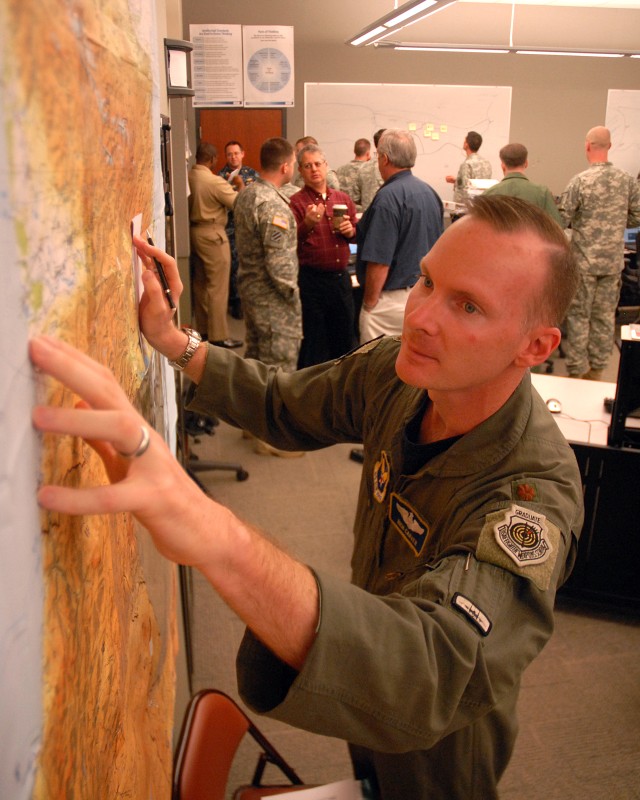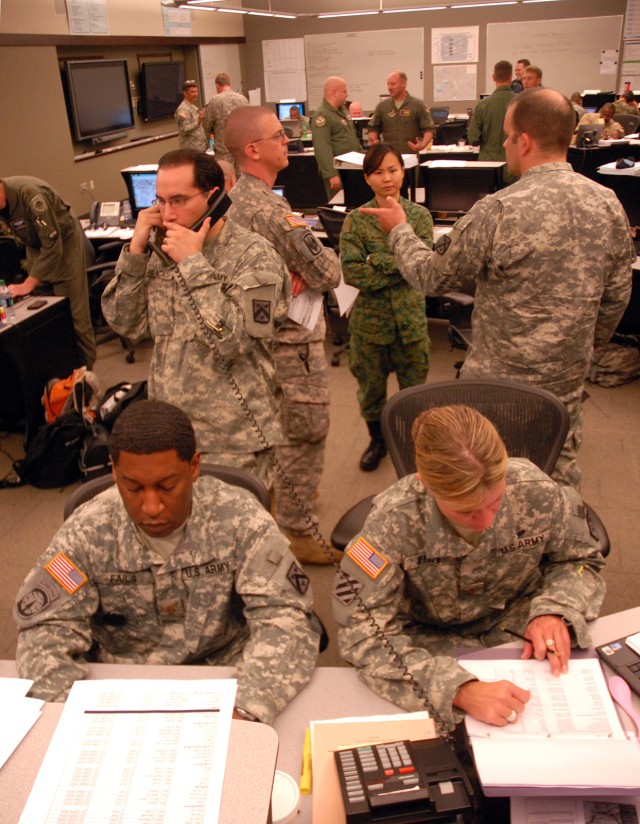FORT LEAVENWORTH, Kan. (March 24, 2011) -- Students at the U.S. Army Command and General Staff College are accustomed to conducting warfighting exercises, but this week had an opportunity to learn alongside joint, international and interagency partners.
The Joint Intermediate Staff Planning Exercise has been conducted since 2003. In addition to staff groups from CGSC, there is participation from the Air Command Staff College at Maxwell Air Force Base, Ala., and Canadian Forces College, the Canadian equivalent to CGSC. Typically the exercise also utilizes general officers and ambassadors as mentors, but the Department of Defense hiring freeze prevented this, so CGSC instructors stepped into this role.
Clay Easterling, assistant professor at CGSC, said two sections are chosen for the exercise, with a few additional Intermediate Level Education students participating. All seven of CGSC's interagency students participated, as well as sister service and international students.
About 100 personnel at the Air Command Staff College participated. Students at Fort Leavenworth used Defense Connect Online to communicate with them, a tool that allows two parties to view a map or set of data and collaborate in real time.
Easterling said DCO is the same tool now being used by former CGSC faculty assigned to U.S. Army Africa Command to enforce a no-fly zone in Libya. In fact, the joint staff working with AFRICOM is even using the same information papers CGSC gives students for DCO, Easterling said.
"Students are excited to have the same thing they'll use after they graduate," he said.
Students used a fictional scenario for the exercise. The joint forces are told to pull out of a country, but another group of insurgents threatens to invade, this time, with weapons of mass destruction.
Maj. Paul Roley, an ILE student in the 2011-01 class, said his normal job is a medical evacuation pilot. In the scenario, he served as a public affairs officer.
"It's a good experience because we're engaging with the media, and I'm getting a different perspective in a staff position," he said.
Air Force Maj. John Dobbin played the role of chief of staff. He said one of the benefits of the exercise was working with Department of State, Department of Justice and United States Agency for International Development. Many of these personnel played themselves in the exercise.
"That usually is one of the most difficult things when we're planning, is coordinating the military side and the Department of State side, because nobody can do it by themselves," he said.
Navy Lt. Cmdr. Dave Grogan said the scenario was a challenge because countries were geographically landlocked. However, the Navy still has resources it can utilize, he said.
"Sometimes as a Navy, we find ourselves trying to prove our role, but we've got stuff we can bring into this, and I can make your job easier," he said.
Canadian Army Maj. Lyna Gravel visited from her staff school to participate in the exercise. A logistics officer in real life, she had the opportunity to work on sustainment and logistics during the exercise. She said the exercise was beneficial because it showed her a few key differences between American and Canadian officers.
"Here they're all specialists," she said. "In Canada, we're more generalized, we can work anywhere in sustainment."
Gravel said she also noticed more resources in the U.S. than in Canada, and different types of equipment. Canada is less digital, but the results for logistics planning tend to be similar, she said.
"We're very close; the process is very similar," she said. "So even if I didn't learn the U.S. process, I learned the Canadian process - it all comes together."
Gravel said the exercise was useful in bringing together military officers from different backgrounds and civilian personnel.
"In real life, we'll have to do that, because if you get deployed to Afghanistan right now, you'll be with other countries," she said. "This is a great way to start that."






Social Sharing